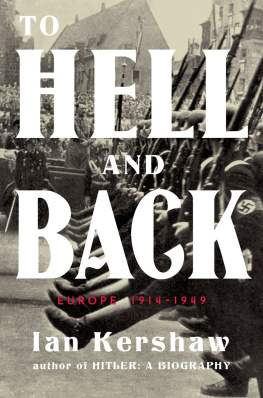I. SIMON PRICE AND PETER THONEMANN: The Birth of Classical Europe: A History from Troy to Augustine
II. CHRIS WICKHAM: The Inheritance of Rome: Illuminating the Dark Ages 4001000
III. WILLIAM CHESTER JORDAN: Europe in the High Middle Ages
IV. ANTHONY GRAFTON: Renaissance Europe*
V. MARK GREENGRASS: Christendom Destroyed: Europe 15171648
VI. TIM BLANNING: The Pursuit of Glory: The Five Revolutions that Made Modern Europe: 16481815
VII: RICHARD J. EVANS: The Pursuit of Power: Europe 18151914
VIII. IAN KERSHAW: To Hell and Back: Europe 19141949
IX. IAN KERSHAW: The Global Age: Europe 19502017
Penguin supports copyright. Copyright fuels creativity, encourages diverse voices, promotes free speech, and creates a vibrant culture. Thank you for buying an authorized edition of this book and for complying with copyright laws by not reproducing, scanning, or distributing any part of it in any form without permission. You are supporting writers and allowing Penguin to continue to publish books for every reader.
Illustration credits on .
List of Illustrations
. The Aldermaston march, April 1958 (Bentley Archive/Popperfoto/Getty Images)
. Checkpoint Charlie, Berlin, 1953 (PhotoQuest/Getty Images)
. Konrad Adenanauer and Robert Schuman, 1951 (AFP/Getty Images)
. Crowds at Stalins funeral, 1953 (Keystone-France/Gamma-Keystone via Getty Images)
. President Tito and Nikita Khrushchev in Belgade, 1963 (Keystone/Hulton Archive/Getty Images)
. Soviet tank destroyed in the Hungarian uprising of 1956 (Sovfoto/UIG/Getty Images)
. Algerian Harkis arriving in France, 1962 (STF/AFP/Getty Images)
. Simone de Beauvoir and Jean-Paul Sartre in Rome, 1963 (Keystone-France/Gamma-Keystone via Getty Images)
. Little Richard on tour in Germany, 1962 (Siegfried Loch K & K/Getty Images)
. Carnaby Street, London (Jean-Philippe Charbonnier/Gamma-Rapho/Getty Images)
. Citron showroom, Paris (Charles Edridge/Getty Images)
. Students and police in Paris, May 1968 (Hulton-Deutsch/Corbis via Getty Images)
. Leonid Brezhnev and Alexander Dubek in Bratislava, 1968 (Keystone-France/Gamma-Keystone via Getty Images)
. Invasion of Czechoslovakia, 1968 (Popperfoto/Getty Images)
. Willy Brandt in Warsaw, 1970 (Bettmann/Getty Images)
. Swiss anti-womens vote poster, 1971 (Swiss National Museum, Zrich)
. Workers demonstration, Lisbon, May 1974 (Herv Gloaguen/Gamma-Rapho via Getty Images)
. Turks in Duisburg, 1980 (Henning Christoph/Ullstein Bild via Getty Images)
. IRA bombing in Belfast, 1972 (Bettmann/Getty Images)
. Pope John Paul II in Warsaw, 1979 (Bettmann/Getty Images)
. Lech Wasa at the Gdansk shipyard, 1980 (Jean-Louis Atlan/Sygma via Getty Images)
. Franois Mitterrand and Helmut Kohl, 1984 (Rgis Bossu/Sygma via Getty Images)
. Margaret Thatcher and Mikhail Gorbachev in Moscow, 1987 (Georges De Keerle/Hulton Archive/Getty Images)
. Leipzig demonstration, 1989 (Georges Merillon/Gamma-Rapho via Getty Images)
. Romanian demonstrator, Bucharest, 1989 (Peter Turnley/Corbis/VCG via Getty Images)
. Anti-Maastricht placards, Provence, 1992 (Philippe Giraud/Sygma via Getty Images)
. Bombing of Sarajevo, 1992 (Georges Gobet/AFP/Getty Images)
. Boris Yeltsin and Vladimir Putin, 1999 (AFP/Getty Images)
. Aftermath of the Madrid train bombing, 2004 (Pool Almagro/Duclos/Vandeville/Gamma-Rapho via Getty Images)
. General strike in Athens, 2010 (Milos Bicanski/Getty Images)
. Pro-Europe demonstration in Ukraine, New Years Eve, 2013/14 (Sergei Supinsky/AFP/Getty Images)
. Turkish policeman with the body of Aylan Shenu, 2015 (Nilufer Demir/Dogan News Agency/AFP/Getty Images)
List of Maps
. The European Union 2018

Preface
To Hell and Back, I wrote in the Preface, was the hardest book I had ever attempted. That was until this book. This second volume on the history of Europe from 1914 to our own times posed still greater problems in both interpretation and composition. This is in no small measure because Europes history between 1950 and the present day has no single overriding theme comparable to the obvious centrality of world war which dominates the predecessor volume that covers the period 1914 to 1949. Europe in the Global Age was no longer in charge of its own destiny. European countries, driven by national interest and aggrandisement of power, had taken the continent into two global wars in 191418 and 193945. The first undermined, and the second sealed, the end of Europes world dominance. Europe after 1945 was rebuilt under the aegis of the new superpowers, the USA and the Soviet Union, both with global interests. Their influence political, military, economic and cultural in shaping the two halves of the new Europe was massive. At the same time immense impersonal global forces were transforming Europe. Global economic growth underpinned unprecedented levels of prosperity in the 1950s and 1960s. During the same period a sweeping process of decolonisation ended Europes long imperial past. Turmoil in the Middle East led to the oil crises of the 1970s that then drastically reshaped the economy, while the end of the Cold War in 198991 brought huge political transformation and new global challenges for Europe. Not least, the astonishing communications revolution of the 1990s and 2000s dramatically accelerated globalisation. The extent of Europes exposure to global forces was in recent years fully revealed through the impact of 9/11, the finance crash of 2008 and the refugee crisis of 201516 that emanated from the Syrian war.
The complexity of Europes history in this era poses significant problems for the architecture of the book. These are compounded by the division of Europe for over forty years by the Iron Curtain. Other than as an idea of shared cultural identity (though one fragmented through religious, national, ethnic and class differences), Europe in these decades did not exist. Its two halves western and eastern Europe were themselves purely political constructs. The internal development of each half of the continent over that period is so different that it is impossible to integrate them in any coherent fashion until the fall of communism between 1989 and 1991. Although Eastern and Western Europe also thereafter remain profoundly different, the impact of rapidly accelerating globalization a key theme of the volume then makes it feasible to deal with them together, rather than separately.




















